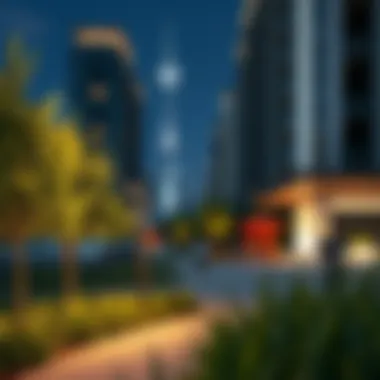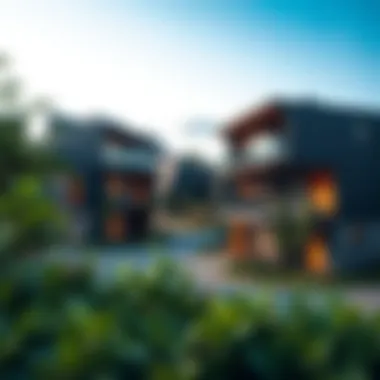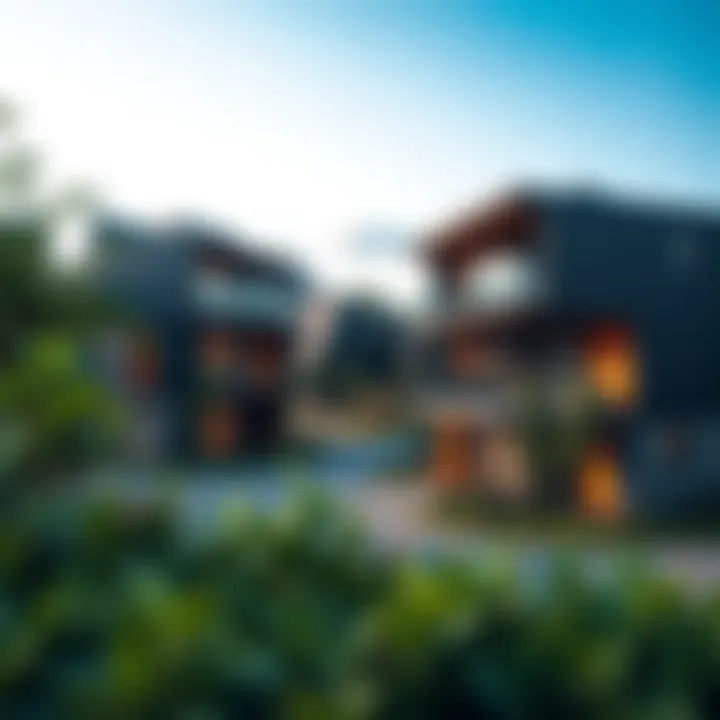Understanding Green Communities in Urban Development


Intro
Green communities represent a shift in how we perceive urban living. They’re not just neighborhoods with a splash of greenery; instead, they embody an entire philosophy focused on sustainability and quality of life. In bustling cities like Dubai, where urban expansion often eclipses environmental considerations, the importance of integrating green practices cannot be overstated. This article will unpack the notion of green communities, evaluating their significance in real estate and urban planning today.
With the rapid growth of urban centers, the need for sustainable living solutions has never been more pressing. Moving beyond traditional building practices, green communities promote an eco-friendly lifestyle that harmonizes with nature. Through initiatives such as renewable energy sources, efficient waste management systems, and communal spaces for interaction, these environments cater to a vision where urban and nature coalesce.
Investors, real estate agents, and potential buyers all stand to gain from understanding this trend, as it fundamentally alters the landscape of property value and desirability. Notably, stakeholders in Dubai's real estate market can especially benefit, given the emirate's push toward a sustainable future. This discussion will encompass market trends, investment opportunities, and the broader implications of constructing communities that prioritize ecological balance.
In the following sections, we will delve deeper into key market trends shaping the green community landscape, explore lucrative investment opportunities, and discuss how adopting sustainable practices can enhance the appeal of residential offerings. To truly comprehend the evolution and relevance of green communities today, let’s first take a closer look at the current market trends.
Understanding Green Communities
In today’s rapidly evolving urban landscape, the notion of green communities is gaining significant traction. These communities present a framework that not only promotes sustainable living but also encourages a holistic approach towards ecological stewardship. Understanding green communities is pivotal for stakeholders, from real estate investors to residents impacted by urban planning decisions. The shift towards sustainability is not merely a trend; it is a necessity anchored in the growing awareness of environmental degradation and climate change.
Green communities are characterized by their commitment to minimizing ecological footprints while maximizing social and economic benefits. This intricate balance supports skills development, community resilience, and sustainable infrastructures, forming a comprehensive ecosystem that nurtures human well-being. For stakeholders looking at the Dubai real estate market, the transition toward greener practices may seem daunting, yet it presents myriad opportunities. A solid grasp of what defines green communities equips these individuals with the knowledge to make informed decisions that align with their values and long-term goals.
- Key Benefits of Understanding Green Communities:
- Enhanced community engagement leads to more robust social networks and shared resources.
- Economic growth through investment in sustainable infrastructure, creating jobs and opportunities.
- Reduced environmental impact, protecting local ecosystems and biodiversity.
In evaluating these benefits, it’s worth noting how they interlink and fuel one another, creating a virtuous cycle of positive outcomes. For instance, when communities engage effectively, it often leads to better support for local businesses, thus fostering economic growth.
It’s imperative to acknowledge that fostering green communities goes beyond ecology; it’s about shaping environments where people thrive in mutual respect with nature, creating space for personal and communal growth.
Definition and Characteristics
A green community, at its essence, is a physical or social environment designed to encourage sustainable living. It is not just about the use of eco-friendly materials; it encompasses an entire ideology rooted in thoughtful planning and purposeful design.
Common characteristics include:
- Integration with nature: Space designed to connect residents with their environment through parks, gardens, and natural habitats.
- Energy efficiency: Buildings are constructed or renovated using practices that reduce energy consumption.
- Sustainable transportation: Communities encourage walking, cycling, and use of public transport to reduce reliance on cars.
- Water conservation: Implementing measures to conserve water, such as rainwater harvesting and irrigation systems that minimize water wastage.
These attributes are crucial, particularly in urban settings like Dubai, where maximizing resources while minimizing waste is vital to long-term viability.
Historical Context
Understanding the historical context in which green communities have evolved provides critical perspective. The concept has roots dating back to the early 20th century, during a time when urban industrialization led to increased pollution and deteriorating living conditions. However, it wasn’t until the late 1960s and 1970s, driven by environmental movements, that the seeds of environmental stewardship began to take stronger root.
- Milestones in the Evolution of Green Communities:
- The establishment of Earth Day in 1970 marked a turning point for environmental awareness globally.
- In the 1990s, initiatives like sustainable development began gaining traction, fostering the idea of communities built around ecological principles.
- The late 2000s saw the rise of certification programs, such as Leadership in Energy and Environmental Design (LEED), which established guidelines for recognizing sustainable building practices.
These developments laid the framework for what we now define as green communities. As urban areas continue to expand, understanding the historical trajectory of these communities can offer valuable insights into future tendencies and planning approaches. The lessons learned through these past efforts serve as critical reference points in shaping today’s and tomorrow's green community initiatives.
Understanding green communities is not merely about grasping their definition and characteristics; it lays the groundwork for embracing ecological responsibility and rethinking our role in urban development. This awareness prompts us toward an integrated future where living harmoniously with nature is a possibility, rather than a luxury.
Environmental Benefits of Green Communities
The formation of green communities has transcended mere urban planning; it embodies a collective aspiration towards a more sustainable existence. By focusing on the environmental benefits of these communities, one uncovers the integral role they play in conserving resources, promoting green practices, and fostering an ecosystem where both nature and humanity thrive. These benefits are especially pertinent for stakeholders in the Dubai real estate market, where rapid urbanization and population growth pose significant environmental challenges.
Reduction of Carbon Footprint
One of the primary environmental benefits of green communities is the substantial reduction of carbon footprints. Traditional urban areas are often characterized by high energy consumption and excessive greenhouse gas emissions. In contrast, green communities prioritize sustainable practices, aiming to minimize the carbon output associated with transportation, energy consumption, and waste.
- Energy Efficiency: Implementing energy-efficient systems in buildings is vital. For instance, solar panels on rooftops not only harness renewable energy but also significantly decrease reliance on fossil fuels.
- Public Transportation and Carpooling: Green communities advocate for efficient public transport systems and carpool arrangements, which cut down on traffic congestion and related emissions. Encouraging residents to utilize public transport can reduce individual carbon footprints immensely.
- Green Spaces: Integration of parks and green roofs acts as natural carbon sinks, absorbing CO2 and promoting cleaner air. It’s like having a breath of fresh air amid the concrete jungle.
These measures not only benefit the immediate community but also contribute to larger efforts to combat climate change on a global scale. Ultimately, the shift towards eco-friendly practices is more than just a trend; it's an essential strategy for future-proofing urban areas against environmental degradation.
Enhancement of Biodiversity
In addition to reducing carbon emissions, green communities play a crucial role in enhancing local biodiversity. This is achieved through strategic planning and design that prioritizes the integration of natural ecosystems within urban settings.
- Habitat Preservation: By setting aside land for wildlife corridors and natural habitats, these communities protect various species from urban development encroachment. It’s a little like creating a sanctuary amidst the whirlwind of city life.
- Native Plants: Encouraging the planting of native flora helps foster biodiversity. Native plants are well-adapted to the local environment and support local wildlife, including pollinators like bees and butterflies.
- Community Gardens: These gardens not only provide fresh produce but also serve as a platform for residents to engage with nature, understand the local ecosystem, and appreciate the importance of biodiversity in sustaining food systems.


The elevation of biodiversity is not merely an aesthetic enhancement; it ensures a balanced ecosystem which is essential for ecological health and resilience. By making conscious choices in landscape design, green communities create thriving environments that support a multitude of species and contribute to the overall vibrancy of urban life.
In summary, the environmental benefits of green communities extend beyond individualistic eco-friendly actions. They represent a collective movement toward a sustainable future that is not just beneficial for the present but also lays the groundwork for future generations. Investors, agents, expatriates, analysts, and buyers in Dubai's real estate market must take heed of these concepts, as they will guide both current practices and future developments in urban living.
Social Aspects of Green Living
The social aspects of green living play an indispensable role in the development of green communities. It encompasses a spectrum of considerations, ranging from community engagement to individual well-being. As urban areas evolve, these aspects help to foster a more connected and healthier society. For those interested in the Dubai real estate market, grasping these social dimensions is vital not only for investment opportunities but also for understanding the broader impacts on residents' quality of life.
Community Engagement and Inclusivity
Community engagement is at the heart of successful green living initiatives. It goes beyond mere participation; it’s about fostering genuine connections among residents. When communities come together to discuss sustainability practices, they create a shared vision for their environment. This collective effort not only empowers individuals but also strengthens the sense of belonging.
In Dubai, various programs have emerged that encourage residents to partake in eco-friendly projects. For instance, local workshops on urban gardening or community clean-up events help individuals develop a stake in their environment. It's in these informal gatherings that relationships blossom, turning neighbors into active stewards of their surroundings.
Moreover, inclusivity is crucial. Every voice matters, whether it's the long-time resident or a newcomer from another country. Listening and responding to the diverse needs of the community ensures that initiatives reflect the collective identity. Designing spaces that are accessible to all, such as parks with wheelchair access or family-friendly zones, signals that everyone has a role in shaping their green community.
Health and Well-being
The health and well-being of residents in green communities cannot be overstated. One of the main goals of these communities is to create environments that promote not just sustainability, but also physical and mental health. Research has shown that living in green spaces can significantly reduce stress levels and enhance overall happiness. This aligns perfectly with the global movements toward holistic well-being.
In Dubai, urban planners are increasingly integrating parks and natural landscapes into residential areas. Having easy access to greenery encourages outdoor activity, which is key to maintaining a healthy lifestyle. Walkable neighborhoods that incorporate walking and biking paths can vastly improve cardiovascular health while reducing vehicular emissions. Fear of roaming the streets is diminishing in communities that prioritize pedestrian safety and green transport options.
Furthermore, the mental health benefits of living in a vibrant community cannot be ignored. A socially-connected community fosters resilience, helping individuals cope better with life’s challenges. Regular community gatherings, whether through cultural festivals or eco-awareness seminars, build social networks that enrich lives and promote a sense of well-being.
"A community where residents actively participate and support each other becomes a safe haven, fostering both mental and physical health endeavors."
Economic Impacts of Green Communities
The backdrop of urban development is evolving, and the economic ramifications of green communities are becoming increasingly significant. The focus on sustainability is not just about the environment; it's also about creating vibrant economies that foster growth. A well-planned green community can provide a plethora of economic advantages, influencing everything from property values to job creation.
Investment Opportunities
Investing in green communities presents a unique frontier for investors, buyers, and urban planners alike. These areas often attract those looking to engage with innovative and sustainable practices. Investors may find various opportunities here:
- Real Estate Development: There is a surge in demand for eco-friendly housing and commercial spaces. Developers are keen on creating energy-efficient buildings that meet green standards, thus capturing a niche market.
- Renewable Energy: Investing in renewable energy projects such as solar and wind power can yield positive returns. As communities look for sustainable energy sources, investors can play a crucial role in funding these initiatives.
- Green Infrastructure: Developing green parks, community gardens, and urban green spaces not only enhances property aesthetics but also increases investment appeal. Public-private partnerships can be beneficial here, combining resources for substantial returns.
Investing in green communities is not just a choice; it’s a commitment to a sustainable future.
Consider this: many consumers today prefer to make socially responsible purchases. As a result, operating businesses in green communities could translate to higher customer loyalty and revenue streams. The initial costs may seem steep, but the long-term benefits often outweigh these upfront investments.
Market Value and Property Prices
The relationship between green communities and property values is a crucial consideration. Properties in eco-conscious neighborhoods tend to command higher prices, reflecting buyer preferences for sustainable living. Some factors influencing this trend include:
- Higher Demand for Green Housing: As more individuals become aware of the benefits of sustainable living, properties in green communities fetch a premium. Investors can capitalize on this growing interest by prioritizing eco-friendly features in their projects.
- Long-Term Savings: Homes designed with energy-efficient materials not only reduce utility costs but also enhance marketability. Potential buyers often consider the long-term savings from lower energy bills a major incentive.
- Community Appeal: Green spaces and sustainable practices can make an area more attractive. The aesthetic and environmental benefits can lead to increased buyer interest, further elevating property prices.
Real estate professionals are noticing that neighborhoods incorporating green features often see less fluctuation in market trends, making them a safer investment choice during economic downturns.
In short, the economic impacts of green communities are far-reaching and multifaceted. From investment opportunities that promise future growth to real estate prices that reflect changing consumer preferences, the economic landscape is shifting toward sustainability. Investors and stakeholders should keep a keen eye on these trends, as the green movement is not merely a fad; it’s reshaping our communities and economies fundamentally.
Sustainable Design Principles
Sustainable design principles stand at the core of any successful green community. They ensure that ecological considerations permeate every aspect of development—from planning and execution to maintenance and operation. These principles are not merely checkboxes on a list; they are frameworks guiding the overall vision of how communities can thrive while reducing their impact on the environment. Investors and developers alike should recognize that integrating these elements can lead to financial benefits, an enhanced image, and a positive social impact.
Energy-Efficient Buildings
When discussing sustainable design, energy-efficient buildings form a fundamental pillar. Such structures are designed not only to minimize energy consumption but also to harness renewable energy sources like solar or wind. It's not just about slapping solar panels on the roof—though that’s certainly part of it.
Rather, it's about intelligent design that maximizes natural light and ventilation, thereby reducing reliance on artificial lighting and HVAC systems. Using advanced insulation techniques, energy-efficient windows, and smart technology contributes to a more sustainable operation. Building codes are increasingly emphasizing these features, so staying ahead of the curve can offer a competitive edge for investors. In short, energy efficiency translates to lower utility bills and a lesser environmental footprint. This very idea resonates with potential buyers looking for long-term cost savings and those keen on an eco-friendly lifestyle.
Water Conservation Measures
Water conservation measures are equally critical in the context of sustainable design. With populations rising and climate variations affecting water availability, the importance of sustainability cannot be overstated. Communities should employ various techniques, such as installing low-flow fixtures, implementing rainwater harvesting systems, and employing xeriscaping in landscaping. These strategies directly correlate to reducing water waste and safeguarding a precious resource—water should never be taken for granted.
Moreover, smart irrigation systems can significantly cut down on excess water usage, allowing homes and parks to flourish whilst conserving moisture. Such components demonstrate a community's commitment to sustainability, attracting eco-conscious residents and showing potential buyers the long-term viability of their investments. The lesson here is simple: sustainable water practices enhance community resilience and foster a shared responsibility for resource conservation.


Use of Sustainable Materials
The materials used in construction speak volumes about a community's commitment to sustainability. Opting for sustainably sourced or recycled materials in building projects not only lessens the carbon footprint associated with manufacturing but also often yields healthier indoor environments. Did you know that materials like reclaimed wood or bamboo can provide aesthetic appeal while being environmentally friendly? They're just the tip of the iceberg.
Moreover, some sustainable materials boast energy-efficient properties. For instance, insulation made from recycled denim or cellulose can effectively regulate temperatures, ensuring a comfortable living space without relying heavily on energy-consuming systems. Sustainable materials come with a reputation of quality and lower lifecycle impact, making them more appealing in the long run.
Incorporating sustainable materials into design reflects a community's integrity, setting a standard that both buyers and investors will find appealing.
Understanding and applying these principles can dramatically influence the trajectory of green communities. They represent not merely a trend but a necessary evolution in urban planning and commitment to future generations.
Regulatory Framework Supporting Green Communities
In the quest for sustainable urban development, the regulatory framework plays a pivotal role in shaping the landscape of green communities. This framework not only provides guidelines for implementation but also incentivizes and supports innovation in design and sustainability practices. Any investor, agent, or urban planner interested in green community development needs to grasp the complexities and intricacies of policies and incentives.
Policies and Incentives
Effective policy measures and well-structured incentives are fundamental to fostering green communities. Governments at various levels have begun to recognize the necessity of promoting sustainability within urban planning.
These policies often include:
- Tax breaks and financial incentives for developers who incorporate eco-friendly design principles in their projects.
- Zoning laws that encourage mixed-use developments and limit urban sprawl.
- Grants and funding opportunities for community-oriented projects that aim to enhance green spaces, such as parks or gardens.
With these incentives, local governments can catalyze investment in sustainable development, making it a win-win situation for both public entities and private developers. Not only do they enhance the quality of life for residents, but they also create a marketplace that is ripe for innovative entrepreneurial ventures. A clear example is the use of density bonuses, which allow developers to build more units if they meet certain sustainability criteria. This kind of policymaking aligns the interests of developers with the long-term goals of the community.
Certification Programs
Certification programs also form an integral part of the regulatory framework supporting green communities. They serve as benchmarks for sustainability and encourage adherence to high environmental standards.
Popular certification schemes include:
- LEED (Leadership in Energy and Environmental Design), which grades buildings on various sustainability metrics.
- BREEAM (Building Research Establishment Environmental Assessment Method), which focuses on sustainable practices in building design.
- Green Star, which is focused on sustainable buildings across various metrics in energy efficiency and environmental impact.
By obtaining these certifications, developers not only enhance the value and appeal of their properties but also instill a sense of trust among potential buyers—all while contributing to a more sustainable environment.
Investors engaged in the Dubai real estate market, for instance, should observe how green certifications are leveraged to increase property desirability and marketability. Furthermore, certified buildings often enjoy lower operational costs, making them attractive from an investment standpoint.
In summary, understanding the regulatory frameworks and the array of policies and certification programs that support green communities is essential for those involved in urban planning and real estate development. This understanding informs better decision-making, ensuring developments are both financially viable and environmentally responsible.
Case Studies of Successful Green Communities
Examining the successes of established green communities serves as a beacon for urban planners, investors, and residents alike. These case studies illustrate practical applications of green principles, showcasing how strategies can be effectively woven into both residential and commercial landscapes. It’s crucial to scrutinize these examples not merely as isolated successes but as a blueprint with adaptable strategies that can be tailored to various environments, including vibrant cities like Dubai.
Local Examples
One of the shining stars in the realm of green communities within the local context is Masdar City in Abu Dhabi. Though technically a bit of a hop from Dubai, it serves as an inspiring instance. This planned city emphasizes sustainability, with a grid layout that maximizes energy efficiency by leveraging natural light and ventilation. The city showcases an array of renewable energy sources, including an ambitious solar energy program aimed at reducing dependency on fossil fuels.
Another compelling example is the Sustainable City in Dubai, often highlighted for its remarkable commitment to sustainable living. It comprises a mix of residential spaces and commercial outlets designed with green roofs, biophilic designs, and solar panels, which together contribute to both energy efficiency and a reduction in the environmental footprint. Residents here often participate in community gardens, which not only serve to provide food but also to foster community ties.
These local examples underscore the importance of integrating sustainability into the fabric of urban living. Not only do they illustrate the potential for energy savings and reduced emissions, but they also enhance the quality of life for those living within these eco-friendly enclaves.
Global Models
Looking beyond local boundaries, there are globally recognized green communities that showcase best practices which can inform nascent initiatives in Dubai and beyond. A notable case is Songdo International Business District in South Korea. This purpose-built city is designed from the ground up with sustainability in mind, featuring extensive green spaces, smart technology for energy management, and a strong emphasis on public transportation to minimize car use.
In Europe, Freiburg has become a model for sustainable city development. The city's commitment to eco-friendly practices has birthed neighborhoods that prioritize solar energy, community involvement, and an extensive cycling infrastructure, allowing citizens to traverse the city with minimal reliance on vehicles.
These global models not only demonstrate established sustainability efforts but also highlight the successes stemming from innovative approaches to urban planning. They offer a treasure trove of insights for Dubai's ambitions toward establishing its green community framework. By drawing lessons from these case studies, stakeholders can better understand what works, refining their own strategies to resonate with regional needs and challenges.
"Green communities are not just an aesthetic or a trend; they're the bedrock for future urban living that respects both people and the planet."
Such case studies ultimately do more than showcase successful examples; they inspire action, demonstrate feasibility, and outline the positive impact that thoughtful design and planning can have on the future of urban life.
Challenges in Developing Green Communities
Creating green communities is not just about planting trees or installing solar panels; it involves navigating a complex web of challenges that can make or break a sustainable initiative. The importance of addressing these challenges cannot be overstated. They affect how we perceive these communities, their feasibility, and their acceptance among the public. Furthermore, overcoming these hurdles paves the way for a successful blueprint that can inspire other communities to adopt similar sustainable practices. Key challenges include financial constraints, public awareness and acceptance, and the ongoing maintenance and sustainability of green initiatives.


Financial Constraints
Financial issues often take center stage in discussions about green community development. Initiatives typically require substantial capital investments, which can deter developers and investors. Traditional funding avenues may not provide sufficient financial support, causing potential projects to stall before they even get off the ground.
In places like Dubai, where the real estate market faces gluts and slowdowns, the financial risk becomes even more pronounced. However, this doesn’t mean that financial constraints are insurmountable. Alternative financing methods such as green bonds and public-private partnerships can be explored.
- Benefits of Innovative Financing:
- It encourages investment in energy-efficient buildings.
- Sustainable projects gain access to environmentally-focused funds.
- Reduces the financial burden on initial investors.
Ultimately, demonstrating long-term savings from sustainable practices, like lower utility bills and increased property values, can help to persuade financial backers of a project’s viability.
Public Awareness and Acceptance
Getting the buy-in from the community is why public awareness is crucial. Individuals need to understand how green communities benefit not only the environment but also their day-to-day lives. A lack of awareness can lead to skepticism, and skepticism can hinder successful project implementation.
Educational campaigns are essential in shifting public opinion. These campaigns should articulate the tangible benefits of going green in simple, relatable terms.
Strategies to Promote Awareness:
- Host community forums and workshops.
- Distribute informative brochures and digital content.
- Utilize social media platforms to reach younger audiences.
Moreover, involving community members in the planning stages helps build a sense of ownership. When people feel invested in a project, they are more likely to support it.
Maintenance and Sustainability
Lastly, even after green communities are built, the journey isn’t over. Long-term maintenance is vital to sustain eco-friendly features over time. Failure to do this can lead to a gradual decrease in the effectiveness of the original designs, defeating the purpose of going green.
Key Considerations for Maintenance:
- Develop ongoing management plans focusing on resource allocation.
- Regularly educate community members on how to care for green spaces.
- Collaborate with local governments for support and training.
Addressing these challenges head-on creates opportunities for growth. A focus on innovative financing, community engagement, and robust maintenance systems can transform the sustainability landscape. As more green communities flourish, they pave the way for a healthier environment and a stronger societal fabric.
The Future of Green Communities
The landscape of urban living is transforming at a brisk pace, as the concept of green communities continues to evolve. These forward-looking developments aim to harmonize human existence with nature, fostering both sustainable lifestyles and thriving economies. Understanding the future of green communities involves recognizing key trends and technological advancements shaping their trajectory. Investors, real estate agents, expatriates, analysts, and buyers all stand to gain from staying abreast of these shifts, as they deeply influence property values and societal well-being.
Technological Innovations
Innovation plays a pivotal role in advancing the goals of green communities. For starters, smart technologies are becoming commonplace in these neighborhoods. From sensor-activated systems that manage energy use to apps that help residents track and reduce their carbon footprints, technology is leading the charge in sustainability. Here are a few notable advancements:
- Energy Management Systems: Building management systems (BMS) utilize artificial intelligence to optimize energy consumption, maintaining comfort while minimizing waste.
- Renewable Energy Solutions: Solar panels and wind turbines are frequently integrated into neighborhood designs, reducing reliance on fossil fuels significantly.
- Smart Water Management: Technologies like rainwater harvesting systems and graywater recycling have gained traction, promoting water conservation and efficient usage.
A surge in the Internet of Things (IoT) applications is also on the horizon, enabling interconnected devices to communicate seamlessly, making homes not just smart but also environmentally friendly. Local authorities and private developers are exploring ways to embed these technologies within city infrastructures. As a result, sustainability is becoming more achievable, leading to reduced utility costs for residents in the long run.
Emerging Trends in Urban Development
The vision for urban environments is not a singular path; it is a route with several emerging trends steering communities toward greener practices. Understanding these trends will be crucial for stakeholders wanting to engage actively in green initiatives. Here are some noteworthy trends shaping green community futures:
- Mixed-Use Developments: These projects integrate residential, commercial, and recreational spaces, promoting walkability and reducing vehicle reliance. This shift caters to the growing preference for living where work and play exist in close proximity.
- Vertical Gardens and Green Roofs: Also gaining popularity are vertical gardens and green roofs, which not only boost aesthetic appeal but also improve air quality and biodiversity. They act as insulators, helping buildings maintain temperatures.
- Community-Centric Designs: Planners are increasingly incorporating communal spaces that promote interaction. Parks, gardens, and recreational areas within these developments encourage social cohesion and community engagement, essential elements of a thriving green community.
"A sustainable future is where technology and design converge to create a harmonious existence between nature and urban life."
Closure
In wrapping up our exploration of green communities, it becomes clear that the significance of this concept extends beyond just environmental concerns. Green communities are pivotal in shaping sustainable urban environments that foster a harmonious coexistence between humans and nature. They encapsulate a vision of living that embraces responsible resource management, community involvement, and economic growth aligned with ecological balance.
A critical aspect of green communities is their potential to reduce carbon emissions. This has far-reaching implications for not only city dwellers but also for the global fight against climate change. Cities like Dubai, where rapid urban expansion often leads to increased environmental strain, stand to benefit immensely from the integration of green practices. Thus, promoting green living can resonate well with investors and developers who are increasingly eco-conscious, demonstrating a strong alignment with future market trends.
Moreover, social aspects shine through. Green communities often emphasize inclusivity and recreational spaces, helping to rebuild community ties. Public parks, urban gardens, and communal facilities foster relationships and encourage active participation among residents. The integration of health and well-being practices, such as access to clean air and green space, contributes positively to the physical and mental health of community members. This brings us to the point that investing in green infrastructure is not merely altruistic; it also enhances property values and market attractiveness.
Key Considerations
- Environmental Impact: The continued reduction of carbon footprints, enhancing biodiversity, and effective waste management should be guiding principles.
- Economic Viability: Understanding the market dynamics allows stakeholders to identify investment opportunities that are both sustainable and lucrative.
- Social Cohesion: Promoting a sense of belonging and responsibility among residents ultimately fosters a vibrant and engaged community life.
"The best time to plant a tree was 20 years ago. The second-best time is now."
This proverb captures the essence of investing in green communities—it's never too late to start making a difference. Let’s cultivate change, not just in the physical landscape but in the mindset of our communities as well.
For further resources and a deeper dive into the nuances of green communities, you may explore:
- Wikipedia on Sustainable Communities
- Britannica: Urban Sustainability
- Green Building Council
- Global Green
- reddit.com/r/GreenCommunities



